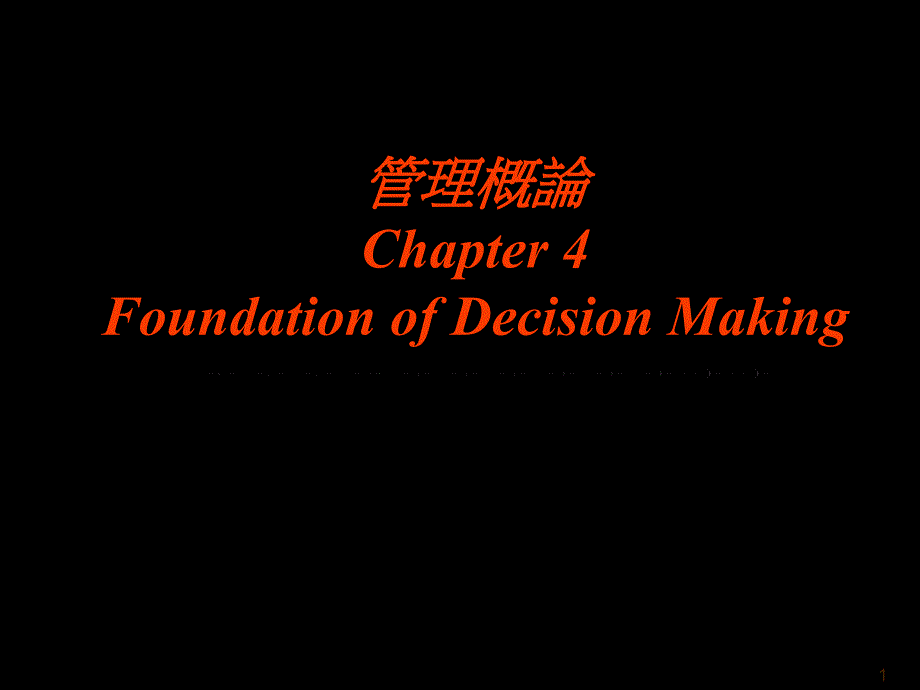 企业经营管理概论(英文版)
企业经营管理概论(英文版)



《企业经营管理概论(英文版)》由会员分享,可在线阅读,更多相关《企业经营管理概论(英文版)(23页珍藏版)》请在装配图网上搜索。
1、管理概論管理概論Chapter 4Foundation of Decision Making1 Learning Outcomes Describe the steps in decision-making process.Identify the assumptions of rational decision-making model.Identify the two types of decision problems and the two types of decisions that are used to solve them.Define heuristics and expl
2、ain how they affect the decision-making process.Describe the advantages and the disadvantages of group decision.2 The Decision-Making ProcessIdentification of a problemIdentification of decision criteriaAllocation of weights to criteriaDevelopment of alternativesAnalysis of alternativesSelection of
3、an alternativeImplementation of the alternativeEvaluation of decision effectiveness3 Step 1:Identification of a problemA discrepancy between an existing and desired state of affairs.Identification of a problemIdentification of decision criteriaAllocation of weights to criteriaDevelopment of alternat
4、ivesAnalysis of alternativesSelection of an alternativeImplementation of the alternativeEvaluation of decision effectiveness4 Step 2:Identification of decision criteriaA manager has to assess what factors are relevant in his decision.Identification of a problemIdentification of decision criteriaAllo
5、cation of weights to criteriaDevelopment of alternativesAnalysis of alternativesSelection of an alternativeImplementation of the alternativeEvaluation of decision effectiveness5 Step 3:Allocation of weights to criteriaIt is necessary to allocate weights to the items listed in step 2 in order to give
6、 them their relative priority in the decision.Identification of a problemIdentification of decision criteriaAllocation of weights to criteriaDevelopment of alternativesAnalysis of alternativesSelection of an alternativeImplementation of the alternativeEvaluation of decision effectiveness6 Step 4:Dev
7、elopment of alternativesNo attempt is made in this step to appraise these alternatives,only to list them.Identification of a problemIdentification of decision criteriaAllocation of weights to criteriaDevelopment of alternativesAnalysis of alternativesSelection of an alternativeImplementation of the
8、alternativeEvaluation of decision effectiveness7 Step 5:Analysis of alternativesEach alternative is evaluated by appraising it against the criteria.Identification of a problemIdentification of decision criteriaAllocation of weights to criteriaDevelopment of alternativesAnalysis of alternativesSelect
9、ion of an alternativeImplementation of the alternativeEvaluation of decision effectiveness8 Step 6:Selection of an alternativeWe merely have to choose the alternative that generated the highest score in step 5.Identification of a problemIdentification of decision criteriaAllocation of weights to cri
10、teriaDevelopment of alternativesAnalysis of alternativesSelection of an alternativeImplementation of the alternativeEvaluation of decision effectiveness9 Step 7:Implementation of the alternativeThis step is concerned with putting the decision into action.Identification of a problemIdentification of
11、decision criteriaAllocation of weights to criteriaDevelopment of alternativesAnalysis of alternativesSelection of an alternativeImplementation of the alternativeEvaluation of decision effectiveness10 Step 8:Evaluation of decision effectivenessThe last step in the decision-making process appraises th
12、e result of decision to see whether it has corrected the problem.(Chapter 13)Identification of a problemIdentification of decision criteriaAllocation of weights to criteriaDevelopment of alternativesAnalysis of alternativesSelection of an alternativeImplementation of the alternativeEvaluation of dec
13、ision effectiveness11 Making Decisions:The Rational ModelThe problem is clear and unambiguous.A single well-defined goal is to be achieved.All alternatives and consequences are known.Preferences are clear.Preferences are constant and stable.No time or cost constraints exist.Final choice will maximiz
14、e economic payoff.12 Modification of the Rational Model Bounded RationalityWhat the managers do is construct simplified models that extract the essential features from problems without capturing all of their complexities.A decision in which“good enough”solutions are selected.13 Common Errors are Com
15、mitted in the Decision-making ProcessHeuristicsvJudgment shortcuts Availability heuristicRepresentative heuristic Escalation of commitment14 How Do Problems DifferWell-structured problemsStraightforward,familiar,easily defined problems.Ill-structured problemsNew problems in which information is ambi
16、guous or incomplete.15 How Do Decisions DifferProgrammed decisionA repetitive decision that can be handled by a routine approach.vProcedurevRulevPolicyNonprogrammed decisionSuch decisions are unique and nonrecurring.16 Types of Problems,Types of Decision,and Level in the Organization Ill-StructuredW
17、ell-StructuredType of problem Top LowerLevel in organizationProgrammed decisionsNonprogrammed decisions17 Decision Making Styles AnalyticConceptualBehavioralDirectiveHighLowRationalIntuitiveWay of ThinkingTolerance for Ambiguity18 Advantages of Group Decision Making provide more complete information
18、 bring a diversity of experience and perspectives generate more alternatives increases acceptance of a solution increases legitimacy19 Disdvantages of Group Decision Making time-consuming inefficient members of a group are never perfectly equal pressures to conform(group think)ambiguous responsibili
19、ty20 Improve Group Decision Making Brainstorming An idea-generating process that encourages alternatives while withholding criticism.Nominal group technique A decision-making technique in which group members are physically present but operate independently.Electronic meeting A type of nominal group technique in which participants are linked by computer.21Thank you!22演讲完毕,谢谢观看!
- 温馨提示:
1: 本站所有资源如无特殊说明,都需要本地电脑安装OFFICE2007和PDF阅读器。图纸软件为CAD,CAXA,PROE,UG,SolidWorks等.压缩文件请下载最新的WinRAR软件解压。
2: 本站的文档不包含任何第三方提供的附件图纸等,如果需要附件,请联系上传者。文件的所有权益归上传用户所有。
3.本站RAR压缩包中若带图纸,网页内容里面会有图纸预览,若没有图纸预览就没有图纸。
4. 未经权益所有人同意不得将文件中的内容挪作商业或盈利用途。
5. 装配图网仅提供信息存储空间,仅对用户上传内容的表现方式做保护处理,对用户上传分享的文档内容本身不做任何修改或编辑,并不能对任何下载内容负责。
6. 下载文件中如有侵权或不适当内容,请与我们联系,我们立即纠正。
7. 本站不保证下载资源的准确性、安全性和完整性, 同时也不承担用户因使用这些下载资源对自己和他人造成任何形式的伤害或损失。
